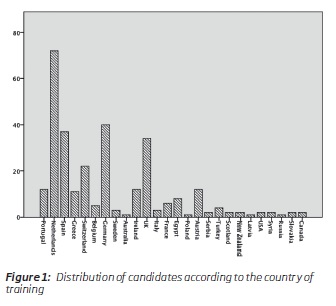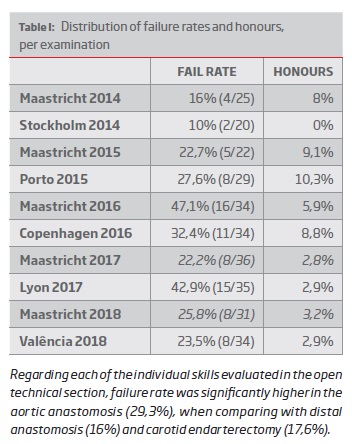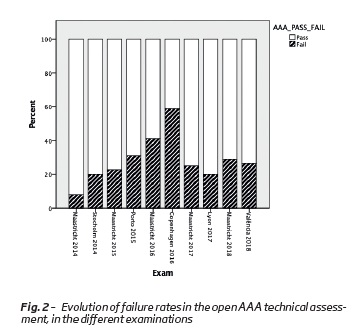Serviços Personalizados
Journal
Artigo
Indicadores
Links relacionados
Compartilhar
Angiologia e Cirurgia Vascular
versão impressa ISSN 1646-706X
Angiol Cir Vasc vol.15 no.3 Lisboa set. 2019
ARTIGO ORIGINAL
European panomara on vascular surgery: results from 5 years of FEBVS examinations
Panorama europeu em cirurgia vascular: resultados de 5 anos de exames FEBVS
Joel Sousa1,2, Armando Mansilha1,2
1 Department of Angiology and Vascular Surgery, Hospital de S. João, Porto, Portugal
2 Faculty of Medicine of the University of Porto
Endereço para correspondência | Dirección para correspondencia | Correspondence
ABSTRACT
Introduction: The Fellow of the European Board of Vascular Surgery (FEBVS) examination is a comprehensive exam for Certified Vascular Surgeons or General Surgeons with Vascular Certification. It comprehends a thorough assessment of vascular pathology knowledge, and includes critical analysis of diverse clinical cases and vascular subjects (Clinical Viva), critical review of an academic paper and direct open and endovascular skills examination in independently validated simulators. It is, therefore, increasingly seen as a standard of quality for International Vascular Specialists, so that it currently represents the final exam for Vascular Surgery Certification in countries such as Netherlands and Switzerland.
Through this work, we aim to perform a critical review on the results of the past ten FEBVS examinations.
Methods: A review of the results from the past ten consecutive FEBVS examinations was performed. Data on the results of open technical skills assessment (aortic anastomosis, distal anastomosis and carotid endarterectomy), endovascular technical skills assessment, clinical viva and academic paper analysis were collected. Candidates demographic characteristics were also reviewed. A review on both global and specific failure rates, as well as their behavior throughout the years was performed.
Results: Three-hundred consecutive candidates, who have performed their Vascular Training in twenty-six different countries, were assessed in 10 different examinations performed in the last 5 years (2014-2018). Most candidates were male (77,7%), with a mean age of 36 years old. The majority of candidates were from the Netherlands (24,1%), although Germany (13,4%), Spain (12,4%) and the United Kingdom (11,4%) had a significant representation as well. Global failure rate was 28,3%, and 5,3% of the candidates were granted “honours” due to outstanding performance (global score > 90%). 21,2% of the failed candidates repeated the exam, with a global pass rate of 56,1%.
Among each of the individual assessments that constitute the exam, failure rate was significantly higher in the academic paper review (24,7%), when comparing to technical open (16%), technical endo (14%) and clinical viva assessments (15,5%).
Regarding each of the individual skills evaluated in the open technical section, failure rate was significantly higher in the aortic anastomosis (29,3%), when comparing with distal anastomosis (16%) and carotid endarterectomy (17,6%). More importantly, a progressive increase of failure rate in aortic anastomosis assessment was observed throughout the years (Fig. 1), in accordance to the known perception of progressive loss of open aortic skills among young physicians.
Portugal represents only 4,2% of all FEBVS candidates, with a pass rate of 100%.
Conclusion: The FEBVS examination is a comprehensive exam, that independently assesses both theoretical and technical knowledge. Failure rate is high, although the existence of “honours” confirms a balanced difficulty level. An alarming loss of open aortic skills is noticeable and reinforces the need of simulation training in such territory.
Keywords: FEBVS; Vascular Surgery; Training.
RESUMO
Introdução: O exame para Fellow of the European Board of Vascular Surgery (FEBVS) é um exame de certificação europeia para Cirurgiões Vasculares ou Cirurgiões Gerais com certificação em Cirurgia Vascular. Este exame compreende uma avaliação extensa da patologia vascular, e inclui a análise crítica de diversos casos clínicos, revisão crítica de um artigo científico e avaliação directa das competências técnicas em cirurgia aberta e endovascular, em diferentes simuladores devidamente certificados. É, por isso, visto cada vez mais como um standard de qualidade para os especialistas em Cirurgia Vascular, de tal forma que constitui o exame de final de especialidade de países como a Holanda ou a Suíça.
Através deste trabalho, pretende-se proceder a uma revisão crítica dos resultados dos últimos 10 exames FEBVS.
Métodos: Foi efectuada uma revisão dos resultados dos últimos 10 exames FEBVS realizados consecutivamente. Procedeu-se à colheita dos resultados referentes à avaliação de competências técnicas em cirurgia aberta (anastomose aórtica, anastomose distal e endarterectomia carotídea), avaliação de competências técnicas em cirurgia endovascular, análise crítica de casos clínicos e revisão de um artigo científico. As características demográficas dos candidatos foram também aferidas. Por fim, procedeu-se à revisão das taxas de insucesso, globais e específicas, assim como à avaliação do seu comportamento ao longo do período de tempo avaliado.
Resultados: Trezentos candidatos, com formação em Cirurgia Vascular realizada em 26 países diferentes, foram avaliados em 10 exames consecutivos realizados ao longo dos últimos 5 anos (2014-2018). A maioria dos candidatos realizaram a sua formação na Holanda (24,1%), embora se observe uma representação igualmente significativa por parte da Alemanha (13,4%), Espanha (12,4%) e Reino Unido (11,4%). 77,7% dos candidatos eram do sexo masculino, com uma idade média de 36 anos.
A taxa de insucesso global foi de 28,3%, e 5,3% dos candidatos foram considerados “honours” atendendo à sua performance excepcional (pontuação global >90%). 21,2% dos candidatos que falharam inicialmente o exame, repetiram-no, com uma taxa de sucesso de 56,1%.
Dentro de cada uma das avaliação individuais que constituem o exame, a taxa de falência foi significativamente maior na revisão do artigo científico (24,7%), quando em comparação com a avaliação de competências técnicas em cirurgia aberta (16%), endovascular (14%), ou análise de casos clínicos.
Em relação a cada um das competências técnicas individuais em cirurgia aberta que foram avaliadas, a taxa de falência foi significativamente maior na anastomose aórtica (29,3%), quando em comparação com a anastomose distal (16%) e endarterectomia carotídea (17,6%). Mais importante, observou-se uma tendência para o aumento da taxa de falência da anastomose aórtica ao longo do período de tempo seleccionado, o que vem de encontro áquilo que é a percepção global dentro da especialidade, nomeadamente de que existe uma perda progressiva de competências técnicas em cirurgia aórtica aberta junto dos jovens profissionais.
Portugal representa apenas 4,2% de todos os candidatos FEBVS, e a taxa de sucesso para o período de tempo avaliado foi de 100%.
Conclusão: O exame FEBVS é um exame completo, que avalia de forma independente, competências técnicas e teóricas. A taxa de insucesso é elevada, embora a existência de “honours” permita inferir que o nível de dificuldade é balanceado. Uma perda progressiva das competências técnicas em cirurgia aórtica aberta tem vindo a ser observada, e reforça a necessidade de treino em simuladores neste território.
Palavras-chave: FEBVS; Cirurgia Vascular; Treino.
Introduction
The Fellow of the European Board of Vascular Surgery (FEBVS) examination is a comprehensive exam for Certified Vascular Surgeons or General Surgeons with Vascular Certification. It comprehends a thorough assessment of vascular pathology knowledge, and includes different evaluation steps, which aim to assess both the clinical as well as the technical skills of each candidate. Due to their independent nature and extensive assessment of different vascular contents, this exam is increasingly seen as a standard of quality for International Vascular Specialists, and currently represents the final exam for Vascular Surgery Certification in countries such as the Netherlands or Switzerland.
The examination is divided in four different sections: academic paper review, open technical skills assessment, endovascular technical skills assessment and clinical review of diverse clinical cases (Clinical Viva and Overall Assessment). Failure in more than one section of each exam will determine failure of the whole exam. In each section, candidates are assessed by two independent examiners. For higher transparency, examiners performance is also independently assessed during each of the sections, and a candidate cannot be examined by an examiner from the same country.
Regarding academic paper review, candidates are expected to quickly review an academic paper, which is only revealed in the day of the examination, and later discuss it with two independent examiners. This exercise aims to evaluate how candidates perform a critical review of an academic paper, particularly in this era of ever-growing conflicting information. On the other hand, and as the name suggests, technical assessments consist on the direct assessment of the candidates technical skills, and comprise both open and endovascular examinations. Open assessment involves the assisted performance of three interventions: aortic anastomosis on an abdominal aortic aneurysm model, a distal anastomosis on a distal bypass model and a carotid endarterectomy. Grading is performed using both the Imperial College Evaluation of Procedure-Specific Skills (ICEPS) and the Objective Structured Assessment of Technical Skills (OSAT) rating scales, and the end product anastomosis is kept for later discussion in case of failure.
Besides open technical assessment, endovascular technical assessment is also performed on validated glass models - Stress Machines(1). This part of the exam comprises two tasks with different difficulty levels, and aims to assess not only how the candidate performs in the selected task, but also if he is able to choose the proper endovascular material for each of the tasks. Finally, the candidates are assessed in several clinical VIVA’s, where they are exposed to different real-life cases. Through these VIVAs, candidates are expected to describe how they would approach different clinical situations, justifying their decisions based on current evidence.
Although there has been a global trend towards standardization of vascular surgical training, current training programs still differ significantly between countries, with no standardization of both surgical curricula nor operative experience among them. Also, there appears to be little evidence for the setting of minimum numbers, making it harder to further assess the efficacy of the different training programs (2).
Since the FEBVS exam involves different candidates from different countries with different surgical training programs, we aimed to review and analyze the results from the past ten FEBVS examinations.
Methods
A review of the results from the past ten consecutive FEBVS examinations (2014-2018) was performed. Data on the results of open technical skills assessment (aortic anastomosis, distal anastomosis and carotid endarterectomy), endovascular technical skills assessment, clinical viva and academic paper analysis were collected. Candidates demographic characteristics such as age, nationality and country of surgical training have also been assessed.
A review on both global and specific failure rates, as well as their behavior throughout the years was performed.
Results
Three-hundred consecutive candidates who have performed their Vascular Training in twenty-six different countries, were assessed in 10 different examinations performed in the last 5 years (2014-2018). Most candidates were male (77,7%), with a mean age of 36 years old. The majority of candidates were from the Netherlands (24,1%), although Germany (13,4%), Spain (12,4%) and the United Kingdom (11,4%) had a significant representation as well (Fig. 1).
Global failure rate was 28,3%, and did not vary significantly between examinations (Table I). Only 21,2% of the failed candidates repeated the exam, and the global pass rate upon res-siting among these was 56,1%.
Candidates with outstanding performance who score >90% of the exam are granted “honours”. In 9 out of 10 examinations, honours were obtained, and the global honours rate was 5,3%, ranging from 0 to 10,3% (Table I).
Among each of the individual assessments that constitute the exam, failure rate was significantly higher in the academic paper review (24,7%), when comparing to technical open (16%), technical endo (14%) and clinical viva assessments (15,5%).
Regarding each of the individual skills evaluated in the open technical section, failure rate was significantly higher in the aortic anastomosis (29,3%), when comparing with distal anastomosis (16%) and carotid endarterectomy (17,6%).
Discussion
These are the first published results from the Fellow of the European Board of Vascular Surgery examinations. It is apparent that, although there has been a global effort to standardize current training programs in Vascular Surgery, up to 28,3% of the candidates, all of them certified surgeons who are legally authorized to perform all vascular procedures, failed this examination. This reveals that there are still significant limitations in current vascular training programs that need to be addressed, especially if mobility is to be taken into account.
Also, by observing these results, it was impressive to note that the higher failure rate occurred in the academic paper review. This is, in the opinion of the authors, extremely important, and something that should be addressed by the national training committees. In fact, the ability to perform a critical review of a paper is of paramount importance for current evidence-based medicine. Also, with the ever increasing number of papers published annually, vascular surgeons must be able to critically review the information that is passed to them, as not all evidence is good evidence.
Failure rate within the technical open assessment was also high (16%), and may reflect the progressive loss of open technical skills in a growing endovascular world. It is particularly interesting to note that, among the different components of the technical open assessment, up to almost one third of the candidates (29,3%) failed the open aortic anastomosis. This reflects the global vascular community impression that open aortic skills are disappearing with the increasing use of EVAR techniques, and is something that should be addressed urgently(3). Although EVAR is a widespread procedure, open aortic aneurysm treatment skills are still of paramount importance for vascular surgeons, particularly when taking into account current evidence regarding the long-term results of EVAR or even some recent guidelines such as the ones published by the Nice committee (4). It is also interesting to see that the failure rate on open AAA anastomosis presented a prospective increasing trend (Fig. 2), further reinforcing the notion that open aortic skills are decreasing progressively in the younger generations.
The “honours” system aims not only to distinguish candidates with outstanding performances, but also to assure a balanced difficulty level within each exam. In fact, if some candidates are able to score >90% of the examination, one must assume that its difficulty level is not excessively high.
Our review demonstrated that honours existed in 9 out of 10 examinations, and the global honours rate was 5,3% (ranging from 0 to 10,3%). As such, a balanced difficulty level was present in the majority of the examinations, further sustaining the reported failure rates.
Finally, not all news are bad news, and when we take a look into our national results, we can gladly assure that vascular surgery training in Portugal is one of the best in Europe. Although Portugal represents only 4,2% of all FEBVS candidates, and therefore our national participation is low when comparing to other countries, for the selected period, the reported pass rate was 100%. Also, among the 12 national candidates who successfully took the exam, 25% of these(3) were granted honours for outstanding performance, from which 2 were given the gold-medal certificate, which is reserved for the candidate with the highest grade within each examination.
Conclusion
The FEBVS examination is a comprehensive exam, that independently assesses both theoretical and technical knowledge. Current failure rate is high, although the existence of “honours” confirms a balanced difficulty level.
There seems to be an alarming loss of open technical skills, particularly open aortic skills, which is consonant with the vascular community perception, and something to worry about in the future, especially if recent publications are to be taken into account. The need for further training in these areas is of paramount importance, and simulation training may present as a solution for some of these situations.
The existence of an high failure rate in the academic paper review reflects lack of critical insight for published evidence, which is a skill growingly important in this changing world.
Portugal is still poorly represented in the FEBVS examinations, as only a small percentage of the Portuguese Vascular Surgeons took the exam. Nonetheless, among these, results are excellent and confirm our training program as one of the best in Europe.
REFERENCES
1. Willems MC, van der Vliet JA, Williams V, Kool LJ, Bergqvist D, Blankensteijn JD. Assessing endovascular skills using the Simulator for Testing and Rating Endovascular Skills (STRESS) machine. Eur J Vasc Endovasc Surg 2009;37:431-6. [ Links ]
2. Elsey EJ, Griffiths G, Humes DJ, West J. Meta-analysis of operative experiences of general surgery trainees during training. Br J Surg 2017;104:22-33. [ Links ]
3. Dua A, Upchurch GR, Jr., Lee JT, Eidt J, Desai SS. Predicted shortfall in open aneurysm experience for vascular surgery trainees. J Vasc Surg 2014;60:945-9.
4. Patel R, Sweeting MJ, Powell JT, Greenhalgh RM, investigators Et. Endovascular versus open repair of abdominal aortic aneurysm in 15-years' follow-up of the UK endovascular aneurysm repair trial 1 (EVAR trial 1): a randomised controlled trial. Lancet 2016;388:2366-74. [ Links ]
Endereço para correspondência | Dirección para correspondencia | Correspondence
Correio eletrónico: joelferreirasousa@gmail.com (J. Sousa).
Recebido a 15 de junho de 2019
Aceite a 15 de outubro de 2019

















